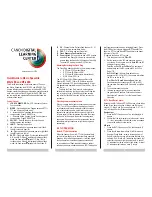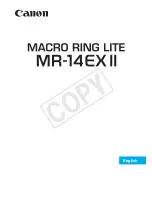
–1
(1)
(2)
–2
2
1
3
4
電気製品は、安全のための注意事項を守ら
ないと、人身への危害や火災などの財産へ
の損害を与えることがあります。
この取扱説明書には、事故を防ぐための重要な注意事項と製品
の取り扱いかたを示しています。この取扱説明書をよくお読
みの上、製品を安全にお使いください。お読みになったあとは、
いつでも見られる所に必ず保管してください。
この「取扱説明書」ではレンズの使いかたを説明
しています。使用上のご注意など、レンズに共
通したご注意や説明については別冊の「使用前
のご注意」でご覧頂けます。
必ずご使用の前に、本書と合わせてよくお読み
のうえでご使用ください。
本機はソニー製αカメラシステム
E
マウントカメラ
専用のレンズです。
A
マウントカメラにはお使いに
なれません。
Sonnar T FE 55mm F1.8 ZA
はソニーとカール
ツァイスの共同開発による
E
マウントカメラ専用の
レンズです。カールツァイスの品質基準に基づき、
カールツァイスによって設定された品質保証シス
テムにより生産されています。
また、
35mm
判相当の撮像素子範囲に対応してい
ます。
35mm
判相当の撮像素子搭載機種ではカメラ設定
によって
APS-C
サイズで撮影が可能です。
カメラの設定方法については、カメラの取扱説明書
をご覧ください。
(カメラ本体との互換情報については)専用サポー
トサイトでご確認ください。
http://www.sony.co.jp/DSLR/support/
使用上のご注意
レンズを取り付けてカメラを持ち運ぶときは、カメラと
ˎ
ˎ
レンズの両方をしっかり持ってください。
本機は防じん、防滴性に配慮して設計されていますが、防
ˎ
ˎ
水性能は備えていません。雨中使用時などは、水滴がか
からないようにしてください。
フラッシュ使用時のご注意
フラッシュ使用時には、レンズフードをはずして
1
m以上
ˎ
ˎ
離れて撮影してください。レンズとフラッシュの組み合
わせによっては、レンズがフラッシュ光を妨げ、写真の下
部に影ができることがあります。
周辺光量について
レンズは原理的に画面周辺部の光量が中心部に比べ低下
ˎ
ˎ
します。周辺光量の低下が気になる場合は、開放絞りか
ら1〜
2
段絞り込んでご使用ください。
各部のなまえ
1
レンズフード指標
2
フォーカスリング
3
レンズ信号接点
*
4
マウント標点
*
直接手で触れないでください。
レンズの取り付けかた/取りはず
しかた
取り付けかた(イラスト
–
参照)
1
前後のレンズキャップとカメラのボディ
キャップをはずす。
レンズフロントキャップは図の(
1
)、
(
2
)の
2
通りの
ˎ
ˎ
方法で取り付け/取りはずしができます。
(
2
)は、レ
ンズフードを付けた状態でのレンズキャップの取り
付け/取りはずしに便利です。
2
レンズとカメラの白の点(マウント標点)を
合わせてはめ込み、レンズを軽くカメラに押
し当てながら、時計方向に「カチッ」とロック
がかかるまでゆっくり回す。
レンズを取り付けるときは、カメラのレンズ取りは
ˎ
ˎ
ずしボタンを押さないでください。
レンズを斜めに差し込まないでください。
ˎ
ˎ
取りはずしかた(イラスト
–
参照)
カメラのレンズ取りはずしボタンを押したま
ま、レンズを反時計方向に回してはずす。
レンズフードを取り付ける
画面外にある光が描写に影響するのを防ぐために、
レンズフードの使用をおすすめします。
レンズフードの赤線をレンズの赤点(レンズ
フード指標)に合わせてはめ込み、レンズフード
の赤点とレンズの赤点が合って「カチッ」という
まで時計方向に回す。
カメラ内蔵、もしくは同梱フラッシュを使って撮影する
ˎ
ˎ
ときは、フラッシュ光が遮られることがありますので、レ
ンズフードをはずしてください。
撮影後レンズフードを収納するときは、逆向きにレンズ
ˎ
ˎ
に取り付けてください。
ピントを合わせる
ピント合わせは、以下
3
つの設定方法があります。
・オートフォーカス
ピント合わせを自動で行う。
・
DMF
(ダイレクトマニュアルフォーカス)
オートフォーカスでピントを合わせた後に、マニュ
アルでピントを微調整する。
・マニュアルフォーカス
ピント合わせを手動で行う。
各モードの設定方法は、カメラの取扱説明書をご覧
ください。
主な仕様
商品名
(型名)
Sonnar T FE 55mm F1.8 ZA
(SEL55F18Z)
35mm
判換算焦点距離
*
1
(
mm
)
82.5
レンズ群一枚
5-7
画角
1*
2
43°
画角
2*
2
29°
最短撮影距離
*
3
(
m
)
0.5
最大撮影倍率(倍)
0.14
最小絞り
F22
フィルター径(
mm
)
49
外形寸法(最大径×長さ)
(約:
mm
)
64.4×70.5
質量(約:
g
)
281
手ブレ補正機能
なし
*
1
ここでの
35mm
判換算焦点距離とは、
APS-C
サイズ相
当の撮像素子を搭載したレンズ交換式デジタルカメラ
での値を表します。
*
2
画角
1
は
35mm
判カメラ、画角
2
は
APS-C
サイズ相当の
撮像素子を搭載したレンズ交換式デジタルカメラでの
値を表します。
*
3
最短撮影距離とは、撮像素子面から被写体までの距離を
表します。
レンズの機構によっては、撮影距離の変化に伴って焦点
ˎ
ˎ
距離が変化する場合があります。記載の焦点距離は撮影
距離が無限遠での定義です。
同梱物
レンズ(
1
)、レンズフロントキャップ(
1
)、
レンズリヤキャップ(
1
)、レンズフード(
1
)、
レンズケース(
1
)、印刷物一式
仕様および外観は、改良のため予告なく変更するこ
とがありますが、ご了承ください。
はソニー株式会社の商標です。
This instruction manual explains how to use lenses.
Precautions common to all lenses such as notes on use
are found in the separate “Precautions before using”. Be
sure to read both documents before using your lens.
This lens is designed for Sony α camera system E-mount
cameras. You cannot use it on A-mount cameras.
The Sonnar T FE 55mm F1.8 ZA was developed jointly
by Carl Zeiss and Sony Corporation and designed for Sony
E-mount cameras. This lens is produced under the strict
standards and quality assurance system of Carl Zeiss.
The Sonnar T FE 55mm F1.8 ZA is compatible with the
range of a 35mm format image sensor.
A camera equipped with a 35mm format image sensor can
be set to shoot at APS-C size.
For details on how to set your camera, refer to its
instruction manual.
For further information on compatibility, visit the Sony
web site in your area, or consult your Sony dealer or local
authorized Sony service facility.
Notes on Use
When carrying a camera with the lens attached, always firmly
ˎ
ˎ
hold both the camera and the lens.
This lens is not water-proof, although designed with dust-
ˎ
ˎ
proofness and splash-proofness in mind. If using in the rain
etc., keep water drops away from the lens.
Precautions on using a flash
When using a flash, always remove the lens hood and shoot
ˎ
ˎ
at least 1 m (3.3 feet) away from your subject. With certain
combinations of lens and flash, the lens may partially block
the light of the flash, resulting in a shadow at the bottom of
the picture.
Vignetting
When using the lens, the corners of the screen become darker
ˎ
ˎ
than the center. To reduce this phenomena (called vignetting),
close the aperture by 1 to 2 stops.
Identifying the Parts
1 Lens hood index
2 Focusing ring
3 Lens contacts
*
4 Mounting index
*
Do not touch the lens contacts.
Attaching and Detaching the Lens
To attach the lens
(See illustration
–
.)
1
Remove the rear and front lens caps and the
camera body cap.
You can attach/detach the front lens cap in two ways, (1)
ˎ
ˎ
and (2). When you attach/detach the lens cap with the
lens hood attached, use method (2).
2
Align the white index on the lens barrel with
the white index on the camera (mounting
index), then insert the lens into the camera
mount and rotate it clockwise until it locks.
Do not press the lens release button on the camera when
ˎ
ˎ
mounting the lens.
Do not mount the lens at an angle.
ˎ
ˎ
To remove the lens
(See illustration
–
.)
While holding down the lens release button on
the camera, rotate the lens counterclockwise
until it stops, then detach the lens.
Attaching the Lens Hood
It is recommended that you use a lens hood to reduce flare
and ensure maximum image quality.
Align the red line on the lens hood with the red
dot on the lens (lens hood index), then insert
the lens hood into the lens mount and rotate it
clockwise until it clicks into place and the red
dot on the lens hood is aligned with the red dot
on the lens.
When using a built-in camera flash or a flash supplied with the
ˎ
ˎ
camera, remove the lens hood to avoid blocking the flash light.
When storing, fit the lens hood onto the lens backwards.
ˎ
ˎ
Focusing
There are three ways to focus.
Auto focus
ˎ
ˎ
The camera focuses automatically.
DMF (Direct manual focus)
ˎ
ˎ
After the camera focuses in auto focus, you can make a fine
adjustment manually.
Manual focus
ˎ
ˎ
You focus manually.
For details on mode settings, refer to the instruction manual
supplied with the camera.
Specifications
Product name
(Model name)
Sonnar T FE 55mm F1.8 ZA
(SEL55F18Z)
Equivalent 35mm-format focal
length*
1
(mm)
82.5
Lens groups-elements
5-7
Angle of view 1*
2
43°
Angle of view 2*
2
29°
Minimum focus*
3
(m (feet))
0.5 (1.64)
Maximum magnification (X)
0.14
Minimum aperture
f/22
Filter diameter (mm)
49
Dimensions (maximum
diameter × height)
(approx., mm (in.))
64.4 × 70.5
(2 5/8 × 2 7/8)
Mass (approx., g (oz))
281 (10)
Shake compensation function
No
*
1
The values shown above for equivalent 35mm-format
focal length are for Interchangeable Lens Digital Cameras
equipped with an APS-C sized image sensor.
*
2
Angle of view 1 is the value for 35mm cameras, and angle of
view 2 is the value for Interchangeable Lens Digital Cameras
equipped with an APS-C sized image sensor.
*
3
Minimum focus is the distance from the image sensor to the
subject.
Depending on the lens mechanism, the focal length may
ˎ
ˎ
change with any change in shooting distance. The focal
lengths given above assume the lens is focused at infinity.
Included items
Lens (1), Front lens cap (1), Rear lens cap (1),
Lens hood (1), Lens case (1), Set of printed documentation
Design and specifications are subject to change without
notice.
is a trademark of Sony Corporation.
Cette notice explique comment se servir des objectifs.
Les précautions communes à tous les objectifs, par
exemple les remarques sur l’emploi, se trouvent sur la
feuille « Précautions avant toute utilisation ». Veuillez
lire les deux documents avant d’utiliser votre objectif.
Votre objectif est conçu pour les appareils photo à monture
E de type Sony α. Il ne peut pas être utilisé pour les appareils
photo à monture A.
Le Sonnar T FE 55mm F1.8 ZA qui a été développé en
collaboration par Carl Zeiss et Sony Corporation est destiné
aux appareils photo à monture E de Sony. Cet objectif a été
fabriqué selon les normes strictes et le système d’assurance
qualité de Carl Zeiss.
4-471-113-
01
(1)
©2013 Sony Corporation
SEL55F18Z
交換レンズ
Interchangeable Lens
Objectif interchangeable
取扱説明書
Operating Instructions
Mode d’emploi
Manual de instrucciones
Sonnar T FE 55mm F1.8 ZA
E-mount
Printed in Thailand
Le Sonnar T FE 55mm F1.8 ZA est compatible avec la
plage d’un capteur d’image de format 35 mm. Un appareil
photo équipé d’un capteur d’image de format 35 mm peut
être réglé pour la prise de vue en APS-C.
Pour les détails sur la manière de régler l’appareil photo,
reportez-vous à son mode d’emploi.
Pour plus d’informations sur la compatibilité, consultez le site
de Sony de votre pays, ou adressez-vous à un revendeur Sony ou
à un service après-vente agréé Sony.
Remarques sur l’emploi
Lorsque vous portez un appareil photo avec l’objectif dessus,
ˎ
ˎ
tenez toujours fermement l’appareil photo et l’objectif.
Cet objectif n’est pas étanche à l’eau bien qu’il soit conçu pour
ˎ
ˎ
résister à la poussière et aux éclaboussures. Si vous l’utilisez
sous la pluie, etc. veillez à ce que de l’eau ne tombe pas dessus.
Précautions concernant l’emploi d’un flash
Lorsque vous utilisez un flash, retirez toujours le parasoleil et
ˎ
ˎ
prenez vos photos à au moins 1 m (3,3 pieds) du sujet. Associé
à certains types de flash, l’objectif peut bloquer partiellement
la lumière du flash et produire un ombre au bas de l’image.
Vignetage
Lorsque l’objectif est utilisé, les coins de l’écran deviennent
ˎ
ˎ
plus sombres que le centre. Pour réduire ce phénomène
(appelé vignetage), fermez l’ouverture de 1 ou 2 crans.
Identification des éléments
1 Repère de parasoleil
2 Bague de mise au point
3 Contacts d’objectif
*
4 Repère de montage
*
Ne touchez pas les contacts d’objectif.
Pose et dépose de l’objectif
Pour poser l’objectif
(Voir l’illustration
–
.)
1
Déposez les capuchons d’objectif avant et
arrière et le capuchon de l’appareil photo.
Vous pouvez poser et déposer les capuchons d’objectif
ˎ
ˎ
avant de deux façons, (1) et (2). Si vous posez/déposez le
capuchon d’objectif avec le parasoleil, utilisez la méthode
(2).
2
Alignez le repère blanc du barillet d’objectif
sur le repère blanc de l’appareil photo
(repère de montage), puis posez l’objectif
sur la monture de l’appareil photo et
tournez-le dans le sens horaire de sorte qu’il
s’encliquette.
N’appuyez pas sur le bouton de libération de l’objectif sur
ˎ
ˎ
l’appareil photo lorsque vous posez l’objectif.
Ne posez pas l’objectif de biais.
ˎ
ˎ
Pour déposer l’objectif
(Voir l’illustration
–
.)
Tout en appuyant sur le bouton de libération de
l’objectif sur l’appareil photo, tournez l’objectif
dans le sens antihoraire jusqu’à l’arrêt, puis
déposez l’objectif.
Fixation du parasoleil
Il est conseillé d’utiliser un parasoleil pour réduire la
lumière parasite et obtenir la meilleure image possible.
Alignez la ligne rouge du parasoleil sur le point
rouge de l’objectif (repère de parasoleil), puis
insérez le parasoleil sur la monture d’objectif et
tournez-le dans le sens horaire jusqu’à ce qu’il
s’encliquette et le point rouge du parasoleil
s’aligne sur le point rouge de l’objectif.
Lorsque vous utilisez le flash intégré d’un appareil photo ou le
ˎ
ˎ
flash fourni avec un appareil photo, retirez le parasoleil pour
éviter de bloquer la lumière du flash.
Pour ranger le parasoleil, insérez-le à l’arrière de l’objectif.
ˎ
ˎ
Mise au point
La mise au point peut être faite de trois façons.
Autofocus
ˎ
ˎ
L’appareil photo fait automatiquement la mise au point.
DMF (Mise au point manuelle directe)
ˎ
ˎ
Après la mise au point en autofocus, vous pouvez effectuer
un réglage plus fin manuellement.
Mise au point manuelle
ˎ
ˎ
Vous faites vous-même la mise au point.
Pour le détail sur les réglages de mode, reportez-vous au
mode d’emploi fourni avec l’appareil photo.
(Suite à la page arrière)




















